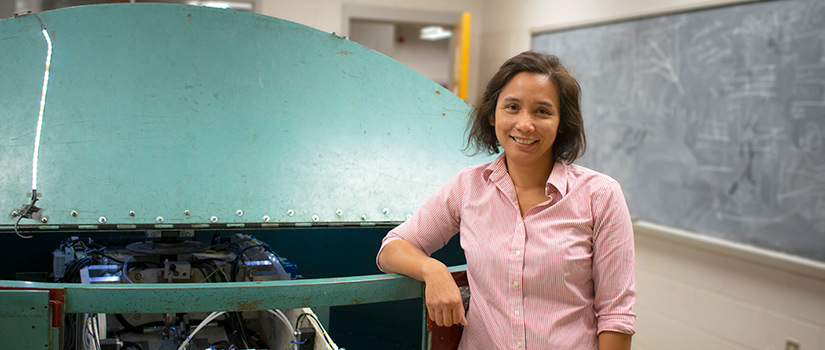By Samantha Winn | September 5, 2019
After experiencing first-hand the devastation that Hurricane Katrina brought upon New Orleans in 2005, Inthuorn Sasanakul has devoted her research to ensuring that this does not happen in South Carolina. With the use of a centrifuge and earthquake shaker, her research is protecting millions of lives by making South Carolina’s infrastructure capable of withstanding even the worst natural disasters.
Located in 300 Main Street, Sasanakul and her students are attempting to answer questions about Earth’s structures and how to improve their design for infrastructure purposes across the state and country.
To do so, they use a centrifuge – a machine that spins at a speed of more than 100 Gs – that helps simulate the conditions of Earth’s rotations to accurately replicate the conditions of dams, bridges and roads in a lab setting. UofSC is one of approximately 20 locations where a centrifuge is held.
She also uses an earthquake shaker, which is only available at less than 10 other institutions in the United States. Like a centrifuge, a shaker can simulate earthquakes. Using the centrifuge in conjunction with the shaker allows Sasanakul to create a parametric study simulating different Earth structures under changing variables.
“In geotechnical engineering, we need to simulate the realistic stress conditions equivalent to the real conditions,” she says. “People spend a lot of money on building full scale and large-scale Earth structures and most of the time they are not going to be the same scale.”
The centrifuge was donated to Sasanakul and the department in 2011 by Professor Deborah Goodings and the University of Maryland. Prior to that, the centrifuge belonged to NASA during the 1980s. Part of Sasanakul’s job upon receiving the centrifuge was updating the equipment by adding new sensors and testing features to the centrifuge and the earthquake shaker.
“The earthquake shaker is a unique piece of equipment, so with design, it needs to be custom made to fit our machine,” Sasanakul explains. “On top of the shake table, we also have a specialized container made of aluminum and when we apply a shake table or earthquake motion, there is nothing restraining it, so that it can freely move when the machine and the model is shaking, and it’s allowed kind of infinite deformations as if it was in the real world.”
Her work updating the centrifuge and the earthquake shaker make UofSC one of six institutions in the country that has both.
Sasanakul’s field and centrifuge experience go back to the aftermath of Hurricane Katrina in New Orleans. She was one of several researchers on the front lines investigating the city’s failed levee systems.
“It was devastating,” she says. “The whole town was covered with mud. The levee failed and all the subdivisions were buried under this clay and sand. It was really eye opening.”
Her study of Katrina didn’t just focus on the water that went over the levee, but also the water that somehow got through the levee without going over its walls. When she first started her research, no one knew exactly why the levee failed. She discovered, though, that the wall of the levee actually moved due to the pressure of the water created by the hurricane. Because of the wall moving, water was able to seep through a gap that was created. This, in turn, led to a “hydrostatic water force” that eventually caused the flood wall to fail.
From the destruction Katrina caused and the research that was done by Sasanakul, changes in the infrastructure and hurricane preparation in Louisiana and other areas in the country were made.
“I'm glad that we were able to find some answers,” she says. “After Katrina, I was involved with looking at other flood walls because the Army came up with different designs for walls so that it didn’t happen again. The reason why I like this research is because what I do is really applied. It’s applied research and – like the work in Katrina – it has been implemented.”
With South Carolina’s track record of experiencing earthquakes, hurricanes and large infrastructure failures, Sasanakul’s research is imperative to helping millions of citizens in the state. She is currently working with SCDOT and has worked with Homeland Security in the past to fix these issues.
“We always try to get something that could be applied to real life,” says William Ovalle, a doctoral assistant working in Sasanakul’s lab. “Sometimes that bridge is not that easy to get. If something from here sometime in the future gets to be used, that would be amazing.”
The use of the centrifuge and earthquake shaker is only one small part of making a larger change in the infrastructure of the state of South Carolina. In the past four years, more than 50 dams in the state have failed.
“I think that everybody should realize that the infrastructure in our country is aging and there’s a time to actually try to improve it and now is a crucial time,” she says. “Everything that we have is just so deteriorated. Our dams have a rating of D, that’s from the Mechanical Society of Civil Engineering. We spend a lot of money on trying to improve technologies, but we also still need good roads, we still need a good dam, we still need a good structures and bridges because these are things that we use every day. We have to look back and see how we can improve on this stuff, especially in our state.”
She feels that the key to a safer future will come from current and future engineers using research and databases to better understand the natural barriers that Earth provides.
"We have hurricanes, earthquakes, floods, we have everything," she says. "But, we also have limited data. We need to collect more data and research to help improve the understanding of our current structures and help improve future design.”
